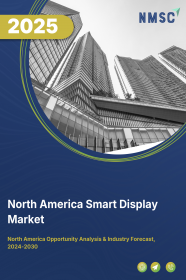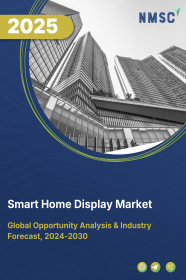
North America Smart Display Market by Display Technology (LCD, LED, E-Paper Display, and Other Display Technologies), by Type (Standalone Smart Displays, Integrated Smart Displays, Interactive Touchscreen Displays, Transparent Smart Displays, and Other Display Types), by Display Size (Below 24 Inch, 24 Inch to 55 Inch, and Above 55 Inch), by Resolution (UHD, FHD, HD, and Others) and Others– Opportunity Analysis and Industry Forecast, 2023–2030
Industry: Semiconductor & Electronics | Publish Date: 15-Feb-2025 | No of Pages: 105 | No. of Tables: 82 | No. of Figures: 45 | Format: PDF | Report Code : SE1012
US Tariff Impact on North America Smart Display Market
Trump Tariffs Are Reshaping Global Business
Market Definition
North America Smart Display Market was valued at USD 2.34 billion in 2022, and is predicted to reach USD 11.75 billion by 2030, with a CAGR of 20.7% from 2023 to 2030. A smart display is a technologically advanced device equipped with a touchscreen or interactive visual interface, integrated with voice recognition and artificial intelligence capabilities.
These displays serve as information hubs that can perform a variety of functions, including displaying information, controlling smart home devices. It provides visual responses to voice commands, enabling video calls, and serving as interactive tools for tasks such as scheduling, weather updates, and entertainment.
Smart displays are designed to enhance convenience, accessibility, and user interactivity in various contexts, such as homes, offices, and public spaces. These displays are utilized in various settings, including residential homes, offices, healthcare facilities, retail, education, and more.
Rising Demand for Smart Displays in North America: Transforming Homes with Convenience and Control
The rapid growth of digitalization in North America has led to an increased desire for smart displays. As consumers enthusiastically adopt smart home technologies to improve their daily lives, smart displays have become essential central hubs for these digital advancements.
They offer an interactive and aesthetically pleasing interface for managing a wide array of connected devices and services, seamlessly integrating into the region's expanding smart home ecosystem. These versatile devices not only enhance convenience and control but also serve as a visual gateway to the interconnected world of modern living.
Energizing Efficiency: Smart Displays Powering Sustainable Living in North America
The unwavering dedication of North America to energy efficiency initiatives is driving the growing adoption of smart displays. These devices play a central role in enhancing energy consumption management and cutting costs for homeowners. By providing real-time information and control over smart thermostats, lighting, and appliances, they are in line with the region's expanding focus on energy-conscious living. Smart displays are now acknowledged as essential tools in the pursuit of energy efficiency and sustainability objectives.
Security Vulnerabilities in Smart Home Displays Restrain Market Growth
Security vulnerabilities in smart display technology represent a significant restraining factor for the smart display market. The potential for security breaches in smart displays poses a substantial risk to users. Insufficient security measures, such as weak passwords and inadequate encryption, could lead to the exposure of sensitive data. Therefore, it is imperative for manufacturers to prioritize robust security features within smart displays, including strong authentication methods and prompt vulnerability patching through regular updates.
Unlocking Opportunities: Introduction of Laser-based Display Technology
Laser-based display technology is presenting substantial opportunities within the smart display market. Its exceptional brightness, color accuracy, long-lasting durability, and energy efficiency position it as a prime choice for diverse applications, spanning from home theaters to outdoor signage and augmented reality experiences.
The extended lifespan and reliability of laser-based displays result in reduced maintenance costs and align with sustainability objectives. As this technology becomes increasingly accessible and cost-effective, it is instigating innovation in the realm of smart displays, particularly in sectors where top-tier visual quality and energy conservation are paramount, thus broadening the market's potential for expansion.
The U.S. Holds the Dominant Market Share in the North American Market
The smart display market in the United States is thriving due to the swift expansion of digitalization and the prominent emphasis on Energy Efficiency Initiatives. As consumers progressively embrace smart home technologies to elevate convenience and control in their digitally connected daily routines, there has been a significant uptick in the demand for smart displays. These displays serve as pivotal central hubs for smart homes, providing an interactive and visually engaging interface to oversee a multitude of connected devices and services.
Canada is Expected to Show Steady Growth in the North American Smart Display Market
Government initiatives in Canada regarding IoT devices are crucial in driving the advancement of the smart display market. These efforts, characterized by financial backing and the creation of regulatory frameworks for IoT technologies, actively contribute to the development of a secure and dependable IoT ecosystem. This serves as a vital groundwork for the broad adoption of smart displays.
These proactive measures not only encourage innovation and enhance consumer confidence but also establish a favorable environment for the growth and integration of smart displays within the expanding IoT landscape. As a result, the smart display market in Canada is experiencing significant growth, propelled by the supportive actions implemented by the government.
An illustrative example of such government involvement occurred in July 2021 when the Department of Innovation, Science, and Economic Development Canada, in collaboration with the Department of Canadian Heritage, initiated public consultations on the modern copyright framework for artificial intelligence (AI) and the Internet of Things (IoT).
This consultation aims to ensure that Canada's copyright regulations for AI and IoT align with the rapid advancements in digital technology, further underscoring the government's commitment to fostering innovation and technological progress, which directly impacts the smart display market in the country.
Competitive Landscape
The North America smart display industry includes several market players such as Samsung Electronics, Qisda Corporation (BenQ), LG Corporation, Sharp Corporation, Lenovo Group Limited, Alps Alpine Co., Ltd, Sony Corporation, Google, LLC., Leyard Optoelectronic Co., and Amazon.com, Inc.
Key Benefits
-
The North America smart display market report provides a quantitative analysis of the current market and estimations through 2023-2030 that assists in identifying the prevailing market opportunities to capitalize on.
-
The study comprises a deep dive analysis of the market trend including the current and future trends for depicting the prevalent investment pockets in the market.
-
The information related to key drivers, restraints, and opportunities and their impact on the market is provided in the report.
-
The competitive analysis of the market players along with their market share in the North America smart display market.
-
The SWOT analysis and Porter’s Five Forces model are elaborated in the study.
-
Value chain analysis in the market study provides a clear picture of the stakeholders’ roles.
North America Smart Display Market Key Segments
By Display Technology
-
LCD
-
LED
-
E-Paper Displays
-
Other Display Technologies
By Type
-
Standalone Smart Displays
-
Integrated Smart Displays
-
Interactive Touchscreen Displays
-
Transparent Smart Displays
-
Other Display Types
By Display Size
-
Below 24 inch
-
24 inch to 55 inch
-
Above 55 inch
By Resolution
-
UHD
-
FHD
-
HD
-
Others
By Sales Channel
-
Direct Sales
-
Retailers and Distributors
-
E-Commerce Or Online Sales
By Application
-
Smart Home
-
Digital Signage
-
Automotive
-
Healthcare
-
Other Applications
By Geography
-
North America
-
U.S.
-
Canada
-
Mexico
-
Key Market Players:
-
Samsung Electronics
-
Qisda Corporation (BenQ)
-
LG Corporation
-
Sharp Corporation
-
Lenovo Group Limited
-
Alps Alpine Co., LTD
-
Sony Corporation
-
Google, LLC.
-
Leyard Optoelectronic Co
-
Amazon.com, Inc.
REPORT SCOPE AND SEGMENTATION:
|
Parameters |
Details |
|
Market Size in 2022 |
USD 2.34 Billion |
|
Revenue Forecast in 2030 |
USD 11.75 Billion |
|
Growth Rate |
CAGR of 20.7% from 2023 to 2030 |
|
Analysis Period |
2022–2030 |
|
Base Year Considered |
2022 |
|
Forecast Period |
2023–2030 |
|
Market Size Estimation |
Billion (USD) |
|
Growth Factors |
Rapid growth of digitalization Energy efficiency initiatives. |
|
Countries Covered |
3 |
|
Companies Profiled |
10 |
|
Market Share |
Available for 10 companies |
|
Customization Scope |
Free customization (equivalent up to 80 working hours of analysts) after purchase. Addition or alteration to country, regional, and segment scope. |
|
Pricing and Purchase Options |
Avail customized purchase options to meet your exact research needs. |

















 Speak to Our Analyst
Speak to Our Analyst



















